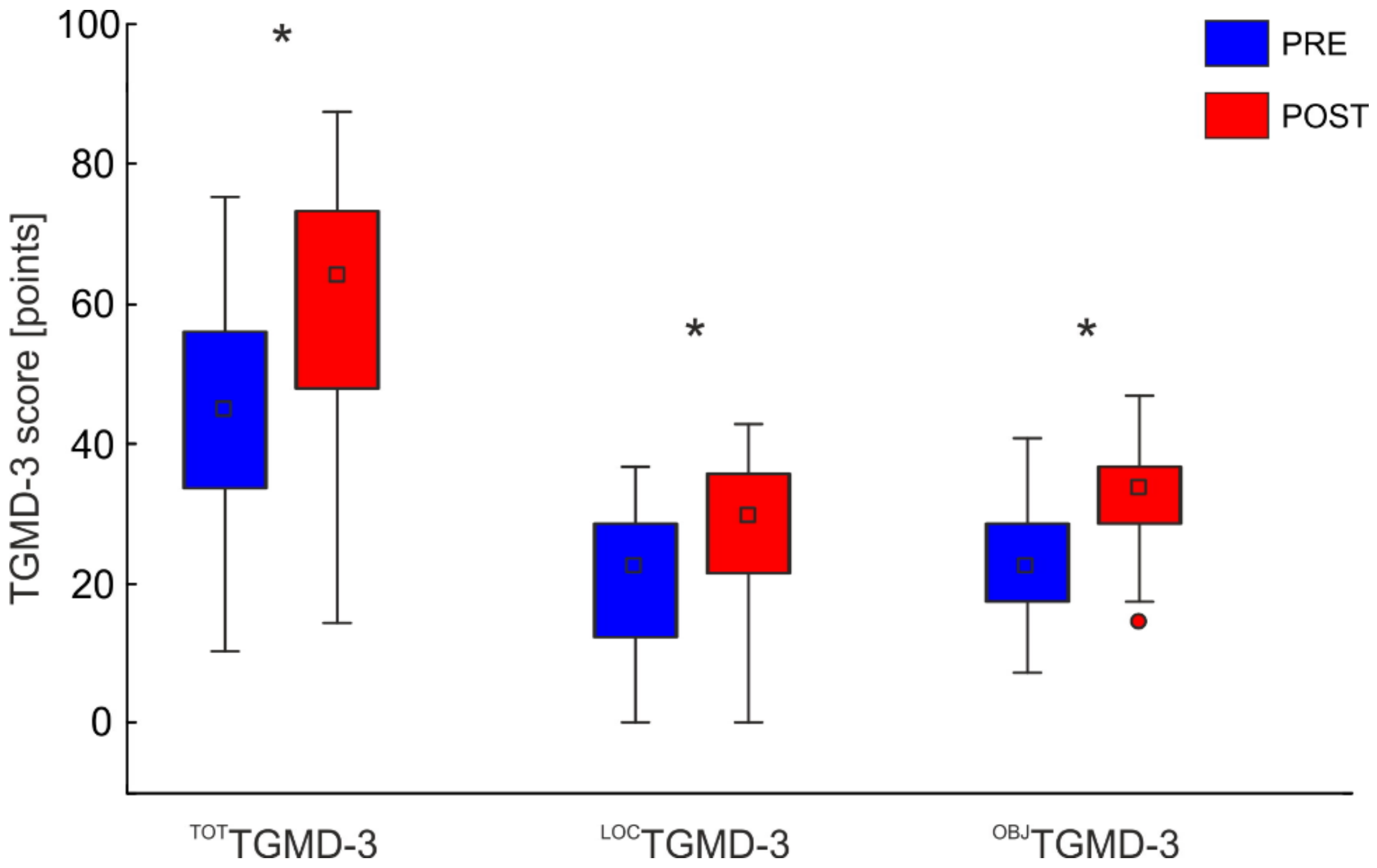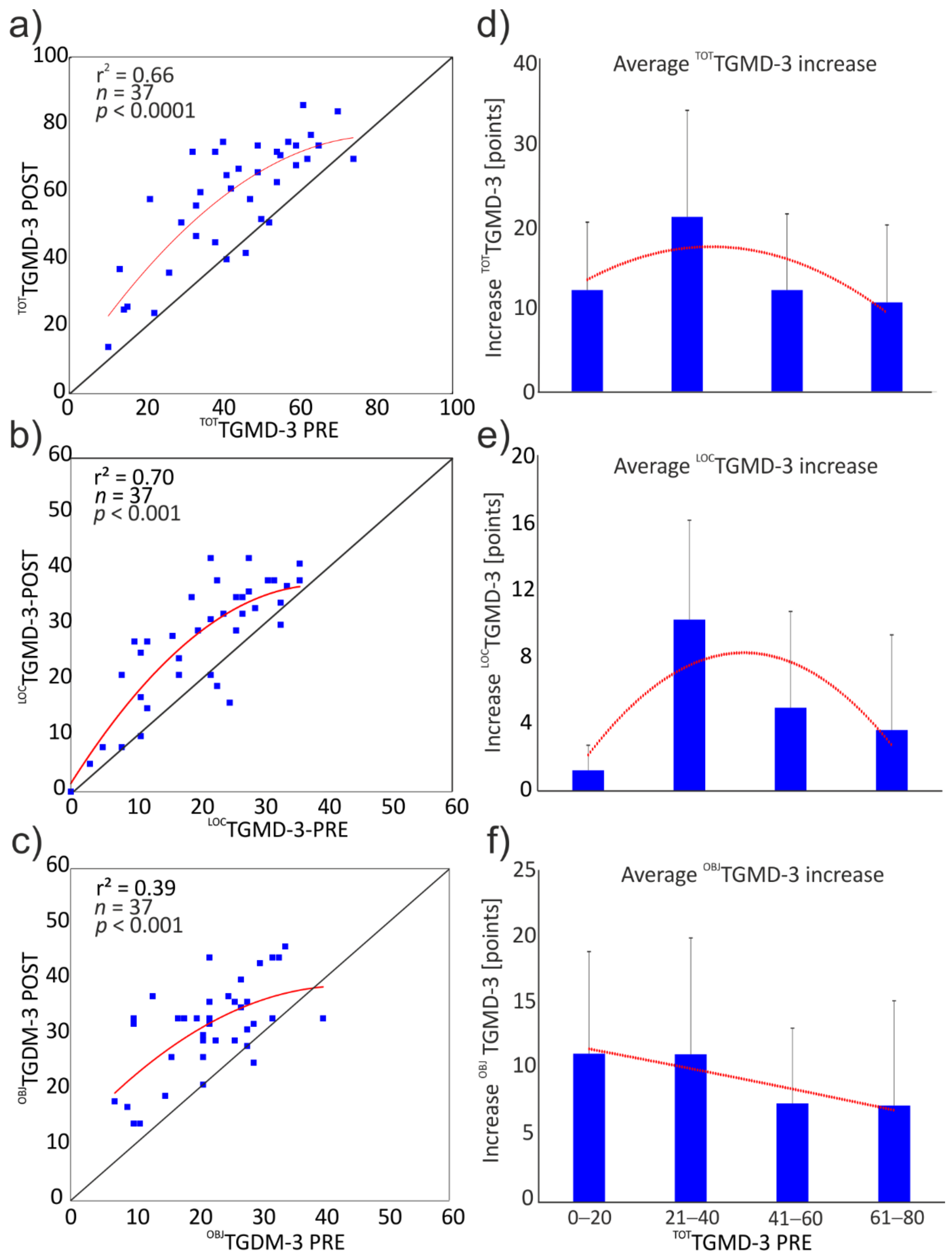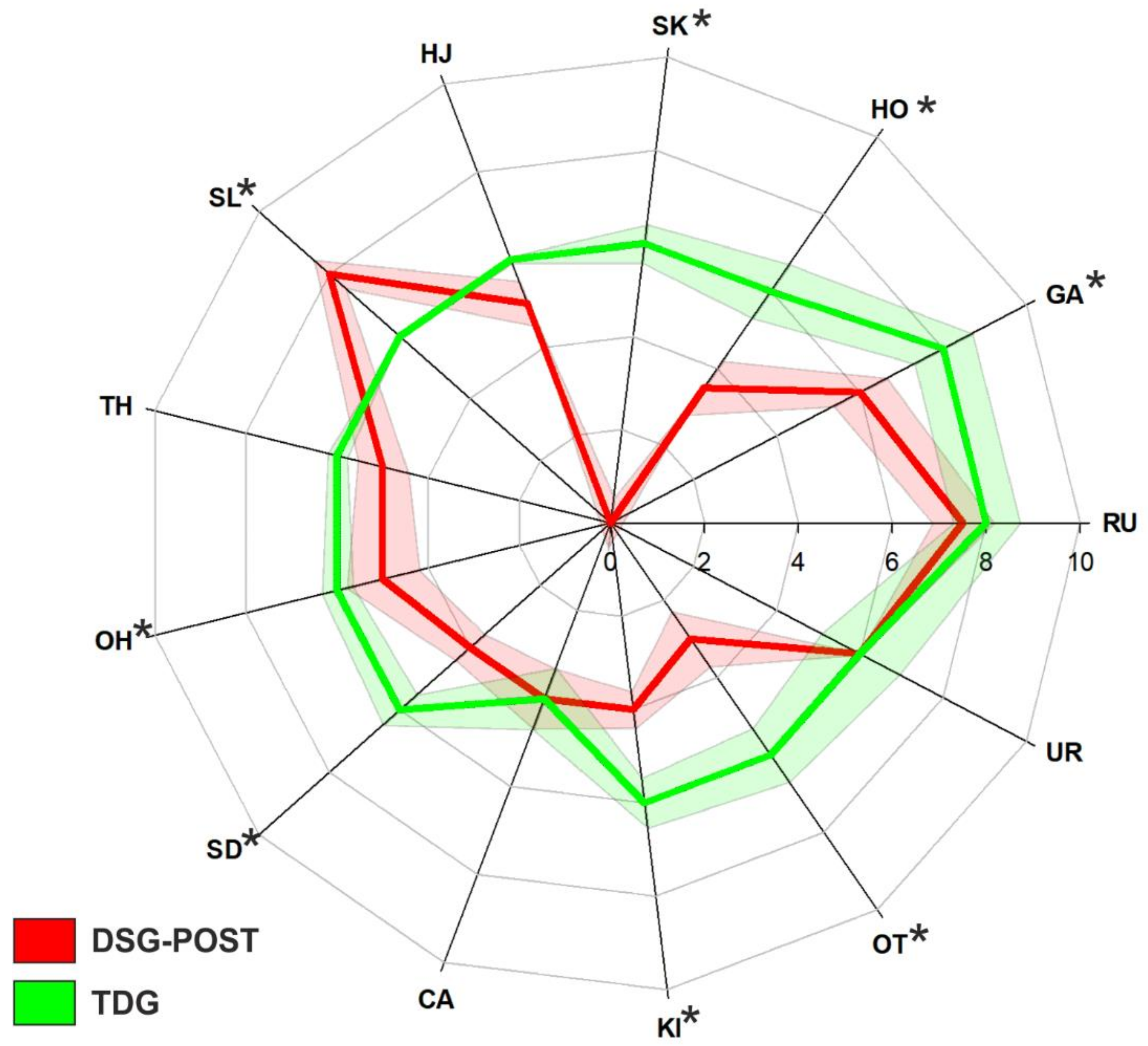Motor Competence in Individuals with Down Syndrome: Is an Improvement Still Possible in Adulthood?
Abstract
1. Introduction
2. Materials and Methods—Study 1
2.1. Participants
2.2. Procedures
2.3. Physical Activity Level
2.4. Statistical Analysis
3. Results—Study 1
4. Materials and Methods—Study 2
4.1. Participants
4.2. Procedures
4.3. Training
4.4. Statistical Analysis
5. Results—Study 2
6. Discussion
7. Conclusions
Author Contributions
Funding
Institutional Review Board Statement
Informed Consent Statement
Data Availability Statement
Acknowledgments
Conflicts of Interest
References
- D’Hondt, E.; Deforche, B.; Gentier, I.; De Bourdeaudhuij, I.; Vaeyens, R.; Philippaerts, R.; Lenoir, M. A longitudinal analysis of gross motor coordination in overweight and obese children versus normal-weight peers. Int. J. Obes. 2013, 37, 61–67. [Google Scholar] [CrossRef] [PubMed]
- Bardid, F.; Vannozzi, G.; Logan, S.W.; Hardy, L.L.; Barnett, L.M. A hitchhiker’s guide to assessing young people’s motor competence: Deciding what method to use. J. Sci. Med. Sport 2019, 22, 311–318. [Google Scholar] [PubMed]
- Seefeldt, V. Developmental motor patterns: Implications for elementary school physical education. In Psychology of Motor Behavior and Sport; Nadeau, C., Holliwell, W., Newell, K., Roberts, G., Eds.; Human Kinetics: Champaign, IL, USA, 1980; pp. 314–323. [Google Scholar]
- Robinson, L.E.; Stodden, D.F.; Barnett, L.M.; Lopes, V.P.; Logan, S.W.; Rodrigues, L.P.; D’Hondt, E. Motor Competence and its Effect on Positive Developmental Trajectories of Health. Sports Med. 2015, 45, 1273–1284. [Google Scholar] [CrossRef] [PubMed]
- Stodden, D.F.; Goodway, J.D. The Dynamic Association Between Motor Skill Development and Physical Activity. J. Phys. Educ. Recreat. Danc. 2007, 78, 33–49. [Google Scholar] [CrossRef]
- Stodden, D.F.; Goodway, J.D.; Langendorfer, S.J.; Roberton, M.A.; Rudisill, M.E.; Garcia, C.; Garcia, L.E. A developmental perspective on the role of motor skill competence in physical activity: An emergent relationship. Quest 2008, 60, 290–306. [Google Scholar] [CrossRef]
- Logan, S.W.; Kipling Webster, E.; Getchell, N.; Pfeiffer, K.A.; Robinson, L.E. Relationship between fundamental motor skill competence and physical activity during childhood and adolescence: A Systematic Review. Kinesiol. Rev. 2015, 4, 416–426. [Google Scholar]
- Utesch, T.; Bardid, F.; Büsch, D.; Strauss, B. The Relationship Between Motor Competence and Physical Fitness from Early Childhood to Early Adulthood: A Meta-Analysis. Sports Med. 2019, 49, 541–551. [Google Scholar] [CrossRef]
- Barnett, L.M.; van Beurden, E.; Morgan, P.J.; Brooks, L.O.; Beard, J.R. Childhood Motor Skill Proficiency as a Predictor of Adolescent Physical Activity. J. Adolesc. Health 2009, 44, 252–259. [Google Scholar] [CrossRef] [PubMed]
- Stodden, D.F.; Langendorfer, S.; Roberton, M.A. The association between motor skill competence and physical fitness in young adults. Res. Q. Exerc. Sport 2009, 80, 223–229. [Google Scholar] [PubMed]
- Stodden, D.F.; True, L.K.; Langendorfer, S.J.; Gao, Z. Associations among selected motor skills and health-related fitness: Indirect evidence for Seefeldt’s proficiency barrier in young adults? Res. Q. Exerc. Sport 2013, 84, 397–403. [Google Scholar] [CrossRef]
- Capio, C.M.; Sit, C.; Eguia, K.F.; Abernethy, B.; Masters, R.S.W. Fundamental movement skills training to promote physical activity in children with and without disability. J. Sport Health Sci. 2015, 4, 235–243. [Google Scholar] [CrossRef]
- Maïano, C.; Hue, O.; April, J. Fundamental movement skills in children and adolescents with intellectual disabilities: A systematic review. J. Appl. Res. Intellect. Disabil. 2019, 32, 1018–1033. [Google Scholar] [CrossRef] [PubMed]
- Pitetti, K.; Miller, R.A.; Loovis, M. Balance and coordination capacities of male children and adolescents with intellectual disability. Adapt. Phys. Act. Q. 2017, 34, 1–18. [Google Scholar] [CrossRef]
- Westendorp, M.; Houwen, S.; Hartman, E.; Visscher, C. Research in Developmental Disabilities Are gross motor skills and sports participation related in children with intellectual disabilities? Res. Dev. Disabil. 2011, 32, 1147–1153. [Google Scholar] [CrossRef]
- Allen, K.A.; Bredero, B.; Van Damme, T.; Ulrich, D.A.; Simons, J. Test of Gross Motor Development-3 (TGMD-3) with the Use of Visual Supports for Children with Autism Spectrum Disorder: Validity and Reliability. J. Autism Dev. Disord. 2017, 47, 813–833. [Google Scholar] [CrossRef]
- Downs, S.J.; Boddy, L.M.; McGrane, B.; Rudd, J.R.; Melville, C.A.; Foweather, L. Motor competence assessments for children with intellectual disabilities and/or autism: A systematic review. BMJ Open Sport Exerc. Med. 2020, 6, e000902. [Google Scholar] [CrossRef]
- Alesi, M.; Battaglia, G.; Pepi, A.; Bianco, A.; Palma, A. Gross motor proficiency and intellectual functioning: A comparison among children with Down syndrome, children with borderline intellectual functioning, and typically developing children. Medicine 2018, 97, e12737. [Google Scholar] [CrossRef]
- Alesi, M.; Battaglia, G. Motor development and Down syndrome. Int. Rev. Res. Dev. Disabil. 2019, 56, 169–211. [Google Scholar] [CrossRef]
- Capio, C.M.; Mak, T.C.T.; Tse, M.A.; Masters, R.S.W. Fundamental movement skills and balance of children with Down syndrome. J. Intellect. Disabil. Res. 2018, 62, 225–236. [Google Scholar] [CrossRef] [PubMed]
- Capio, C.M.; Rotor, E.R. Fundamental movement skills among filipino children with Down syndrome. J. Exerc. Sci. Fit. 2010, 8, 17–24. [Google Scholar] [CrossRef][Green Version]
- Schott, N.; Holfelder, B. Relationship between motor skill competency and executive function in children with Down’s syndrome. J. Intellect. Disabil. Res. 2015, 59, 860–872. [Google Scholar] [CrossRef] [PubMed]
- Palisano, R.J.; Walter, S.D.; Russell, D.J.; Rosenbaum, P.L.; Gémus, M.; Galuppi, B.E.; Cunningham, L. Gross Motor Function of Children with Down Syndrome: Creation of Motor Growth Curves. Arch. Phys. Med. Rehabil. 2001, 82, 494–500. [Google Scholar] [CrossRef]
- Jobling, A. Motor Development in School-Aged Children with Down Syndrome: A longitudinal perspective. Int. J. Disabil. Dev. Educ. 1998, 45, 283–293. [Google Scholar] [CrossRef]
- Leversen, J.S.; Haga, M.; Sigmundsson, H. From children to adults: Motor performance across the life-span. PLoS ONE 2012, 7, e38830. [Google Scholar] [CrossRef]
- Sigmundsson, H.; Lorås, H.; Haga, M. Assessment of motor competence across the life span: Aspects of reliability and validity of a new test battery. SAGE Open 2016, 6, 2158244016633273. [Google Scholar] [CrossRef]
- Quinzi, F.; Camomilla, V.; Bratta, C.; Piacentini, M.F.; Sbriccoli, P.; Vannozzi, G. Hopping skill in individuals with Down syndrome: A qualitative and quantitative assessment. Hum. Mov. Sci. 2021, 78, 102821. [Google Scholar] [CrossRef] [PubMed]
- Quinzi, F.; Camomilla, V.; Sbriccoli, P.; Piacentini, M.F.; Vannozzi, G. Assessing motor competence in kicking in individuals with Down syndrome through wearable motion sensors. J. Intellect. Disabil. Res. 2022. published ahead of print. [Google Scholar] [CrossRef]
- Shields, N.; Plant, S.; Warren, C.; Wollersheim, D.; Peiris, C. Do adults with Down syndrome do the same amount of physical activity as adults without disability? A proof of principle study. J. Appl. Res. Intellect. Disabil. 2018, 31, 459–465. [Google Scholar] [CrossRef]
- Phillips, A.C.; Holland, A.J. Assessment of Objectively Measured Physical Activity Levels in Individuals with Intellectual Disabilities with and without Down’s Syndrome. PLoS ONE 2011, 6, e28618. [Google Scholar] [CrossRef]
- Gupta, S.; Rao, B.K.; Kumaran, S. Effect of strength and balance training in children with Down’s syndrome: A randomized controlled trial. Clin. Rehabil. 2011, 25, 425–432. [Google Scholar] [CrossRef]
- Carmeli, E.; Kessel, S.; Coleman, R.; Ayalon, M. Effects of a treadmill walking program on muscle strength and balance in elderly people with Down syndrome. J. Gerontol. Ser. A Biol. Sci. Med. Sci. 2002, 57, M106–M110. [Google Scholar] [CrossRef]
- Shields, N.; Taylor, N.F.; Dodd, K.J. Effects of a community-based progressive resistance training program on muscle performance and physical function in adults with Down syndrome: A randomized controlled trial. Arch. Phys. Med. Rehabil. 2008, 89, 1215–1220. [Google Scholar] [CrossRef] [PubMed]
- McGuire, M.; Long, J.; Esbensen, A.J.; Bailes, A.F. Adapted Dance Improves Motor Abilities and Participation in Children with Down Syndrome: A Pilot Study. Pediatric Phys. Ther. 2019, 31, 76–82. [Google Scholar] [CrossRef] [PubMed]
- Regaieg, G.; Kermarrec, G.; Sahli, S. Designed game situations enhance fundamental movement skills in children with Down syndrome. J. Intellect. Disabil. Res. 2020, 64, 271–279. [Google Scholar] [CrossRef] [PubMed]
- Alesi, M.; Bianco, A.; Padulo, J.; Vella, F.P.; Petrucci, M.; Paoli, A.; Palma, A.; Pepi, A. Motor and cognitive development: The role of karate. Muscles Ligaments Tendons J. 2014, 4, 114–120. [Google Scholar] [CrossRef] [PubMed]
- Zareian, E.; Delavarian, F. Effect of sport stacking on fine motor proficiency of children with Down syndrome. Int. J. Sport Stud. 2014, 4, 1010–1016. [Google Scholar]
- Holzapfel, S.D.; Ringenbach, S.D.R.; Mulvey, G.M.; Sandoval-Menendez, A.M.; Cook, M.R.; Ganger, R.O.; Bennett, K. Improvements in manual dexterity relate to improvements in cognitive planning after assisted cycling therapy (ACT) in adolescents with down syndrome. Res. Dev. Disabil. 2015, 45–46, 261–270. [Google Scholar] [CrossRef]
- Bartlo, P.; Klein, P.J. Physical activity benefits and needs in adults with intellectual disabilities: Systematic review of the literature. Am. J. Intellect. Dev. Disabil. 2011, 116, 220–232. [Google Scholar] [CrossRef]
- Alesi, M.; Battaglia, G.; Roccella, M.; Testa, D.; Palma, A.; Pepi, A. Improvement of gross motor and cognitive abilities by an exercise training program: Three case reports. Neuropsychiatr. Dis. Treat. 2014, 10, 479–485. [Google Scholar] [CrossRef]
- Quinzi, F.; Camomilla, V.; Felici, F.; Di Mario, A.; Sbriccoli, P. Agonist and antagonist muscle activation in elite athletes: Influence of age. Eur. J. Appl. Physiol. 2015, 115, 47–56. [Google Scholar] [CrossRef]
- Quinzi, F.; Camomilla, V.; Felici, F.; Di Mario, A.; Sbriccoli, P. Differences in neuromuscular control between impact and no impact roundhouse kick in athletes of different skill levels. J. Electromyogr. Kinesiol. 2013, 23, 140–150. [Google Scholar] [CrossRef]
- Sbriccoli, P.; Camomilla, V.; Di Mario, A.; Quinzi, F.; Figura, F.; Felici, F. Neuromuscular control adaptations in elite athletes: The case of top level karateka. Eur. J. Appl. Physiol. 2010, 108, 1269–1280. [Google Scholar] [CrossRef]
- Quinzi, F.; Bianchetti, A.; Felici, F.; Sbriccoli, P. Higher torque and muscle fibre conduction velocity of the Biceps Brachii in karate practitioners during isokinetic contractions. J. Electromyogr. Kinesiol. 2018, 40, 81–87. [Google Scholar] [CrossRef]
- Filingeri, D.; Bianco, A.; Zangia, D.; Paoli, A.; Palma, A. Is karate effective in improving postural control? Arch. Budo 2007, 8, 191–194. [Google Scholar] [CrossRef]
- Del Percio, C.; Babiloni, C.; Marzano, N.; Iacoboni, M.; Infarinato, F.; Vecchio, F.; Lizio, R.; Aschieri, P.; Fiore, A.; Toràn, G.; et al. “Neural efficiency” of athletes’ brain for upright standing: A high-resolution EEG study. Brain Res. Bull. 2009, 79, 193–200. [Google Scholar] [CrossRef]
- Ulrich, D.A. Test of Gross Motor Development, 3rd ed.; University of Michigan: Austin, TX, USA, 2016; Available online: https://www.kines.umich.edu/tgmd-3 (accessed on 22 December 2021).
- Craig, C.L.; Marshall, A.L.; Sjöström, M.; Bauman, A.E.; Booth, M.L.; Ainsworth, B.E.; Oja, P. International physical activity questionnaire: 12-Country reliability and validity. Med. Sci. Sports Exerc. 2003, 35, 1381–1395. [Google Scholar] [CrossRef]
- Fritz, C.O.; Morris, P.E.; Richler, J.J. Effect Size Estimates: Current Use, Calculations, and Interpretation. J. Exp. Psychol. 2012, 141, 2–18. [Google Scholar] [CrossRef] [PubMed]
- Malak, R.; Kotwicka, M.; Krawczyk-Wasielewska, A.; Mojs, E.; Samborski, W. Motor skills, cognitive development and balance functions of children with Down syndrome. Ann. Agric. Environ. Med. 2013, 20, 803–806. [Google Scholar] [PubMed]
- Nakagawa, K.; Kawashima, S.; Mizuguchi, N.; Kanosue, K. Difference in activity in the supplementary motor area depending on limb combination of hand–foot coordinated movements. Front. Hum. Neurosci. 2016, 10, 499. [Google Scholar] [CrossRef] [PubMed]
- Griffiths, A.; Toovey, R.; Morgan, P.E.; Spittle, A.J. Psychometric properties of gross motor assessment tools for children: A systematic review. BMJ Open 2018, 8, e021734. [Google Scholar] [CrossRef]




| DS (n = 57) | TDG (n = 21) | T-Value | p-Value | |
|---|---|---|---|---|
| Age [years] | 26.0 (7.4) | 24.3 (2.1) | 1.06 | 0.290 |
| Mass [kg] | 65.8 (14.5) | 63.9 (11.6) | 0.52 | 0.601 |
| Height [m] * | 1.54 (0.09) | 1.66 (0.06) | −5.27 | <0.001 |
| BMI [kg/m2] * | 27.5 (6.3) | 23.5 (4.0) | 2.79 | 0.006 |
| IPAQ * | 1377.2 (1336.4) | 4026.2 (3487.8) | −4.88 | <0.001 |
| 155.7 (456.9) | 2089.5 (2828.4) | −5.04 | <0.001 |
| 590.9 (848.5) | 775.2 (584.1) | −0.91 | 0.360 |
| 625.8 (501.5) | 1159.3 (2025.4) | −1.85 | 0.067 |
| Females/Males | 21 (37%)/36 (63%) | 11 (52%)/10 (48%) |
| Skill | DSG (n = 57) | TDG (n = 21) | Z-Value | p-Value | Cohen’s d |
|---|---|---|---|---|---|
| Running—RU * | 4.0 (0.742) | 8.0 (0.674) | −3.55 | <0.001 | 0.878 |
| Galloping—GA * | 6.0 (0.579) | 8.0 (0.719) | −3.40 | <0.001 | 0.834 |
| Hopping—HO * | 3.0 (0.806) | 6.0 (0.709) | −4.97 | <0.001 | 1.362 |
| Skipping—SK * | 0.0 (0.362) | 6.0 (0.414) | −5.14 | <0.001 | 1.431 |
| Horizontal Jumping—HJ * | 4.0 (0.589) | 6.0 (0.044) | −2.72 | 0.006 | 0.647 |
| Sliding—SL * | 6.0 (0.658) | 6.0 (0.0) | −2.32 | 0.020 | 0.544 |
| Two-hand striking—TH * | 5.0 (0.771) | 6.0 (0.291) | −2.03 | 0.041 | 0.472 |
| One-hand striking—OH * | 2.0 (0.505) | 6.0 (0.354) | −5.63 | <0.001 | 1.655 |
| Stationary dribbling—SD * | 3.0 (0.712) | 6.0 (0.487) | −3.43 | <0.001 | 0.843 |
| Catching—CA * | 3.0 (0.542) | 4.0 (0.671) | −3.93 | <0.001 | 0.994 |
| Kicking—KI * | 2.0 (0.452) | 6.0 (0.500) | −4.49 | <0.001 | 1.181 |
| Overarm throwing—OT * | 2.0 (0.417) | 6.0 (0.704) | −5.63 | <0.001 | 1.655 |
| Underarm rolling—UR * | 5.0 (0.570) | 6.0 (0.940) | −4.48 | <0.001 | 1.177 |
| DS (n = 37) | |
|---|---|
| Age [years] | 26.2 (8.3) |
| Mass [kg] | 67.0 (12.2) |
| Height [m] | 1.56 (0.09) |
| BMI [kg/m2] | 27.5 (5.4) |
| IPAQ | 1699.4 (1519.6) |
| Females/Males | 10 (27%)/27 (73%) |
| Skill | DSG-PRE (n = 37; 10F) | DSG-POST (n = 37; 10F) | Z-Value | p-Value | Cohen’s d |
|---|---|---|---|---|---|
| Running—RU * | 5.5 (0.852) | 7.5 (0.652) | −3.551 | <0.001 | 0.906 |
| Galloping—GA * | 5.0 (0.788) | 6.0 (0.682) | −1.536 | 0.125 | 0.363 |
| Hopping—HO * | 2.5 (0.848) | 3.5 (0.797) | −1.804 | 0.071 | 0.429 |
| Skipping—SK * | 0.0 (0.371) | 0.0 (0.585) | −0.960 | 0.337 | 0.225 |
| Horizontal Jumping—HJ * | 3.0 (0.787) | 5.0 (0.574) | −3.153 | <0.002 | 0.788 |
| Sliding—SL * | 6.0 (0.952) | 8.0 (0.520) | −4.091 | <0.001 | 1.081 |
| Two-hand striking—TH * | 4.0 (0.601) | 5.0 (0.572) | −1.685 | 0.092 | 0.399 |
| One-hand striking—OH * | 3.0 (0.538) | 5.0 (0.759) | −3.895 | <0.001 | 1.016 |
| Stationary dribbling—SD * | 3.0 (0.639) | 4.0 (0.506) | −2.332 | 0.019 | 0.563 |
| Catching—CA * | 2.0 (0.560) | 4.0 (0.737) | −3.988 | <0.001 | 1.046 |
| Kicking—KI * | 3.0 (0.560) | 4.0 (0.481) | −3.283 | <0.002 | 0.826 |
| Overarm throwing—OT * | 2.0 (0.442) | 3.0 (0.770) | −1.788 | 0.074 | 0.425 |
| Underarm rolling—UR * | 5.0 (0.715) | 6.0 (0.054) | −4.247 | <0.001 | 1.135 |
Publisher’s Note: MDPI stays neutral with regard to jurisdictional claims in published maps and institutional affiliations. |
© 2022 by the authors. Licensee MDPI, Basel, Switzerland. This article is an open access article distributed under the terms and conditions of the Creative Commons Attribution (CC BY) license (https://creativecommons.org/licenses/by/4.0/).
Share and Cite
Quinzi, F.; Vannozzi, G.; Camomilla, V.; Piacentini, M.F.; Boca, F.; Bortels, E.; Kathrein, E.; Magyar, A.; Verdone, F.; Sbriccoli, P. Motor Competence in Individuals with Down Syndrome: Is an Improvement Still Possible in Adulthood? Int. J. Environ. Res. Public Health 2022, 19, 2157. https://doi.org/10.3390/ijerph19042157
Quinzi F, Vannozzi G, Camomilla V, Piacentini MF, Boca F, Bortels E, Kathrein E, Magyar A, Verdone F, Sbriccoli P. Motor Competence in Individuals with Down Syndrome: Is an Improvement Still Possible in Adulthood? International Journal of Environmental Research and Public Health. 2022; 19(4):2157. https://doi.org/10.3390/ijerph19042157
Chicago/Turabian StyleQuinzi, Federico, Giuseppe Vannozzi, Valentina Camomilla, Maria Francesca Piacentini, Florin Boca, Eric Bortels, Eva Kathrein, Adrian Magyar, Fabio Verdone, and Paola Sbriccoli. 2022. "Motor Competence in Individuals with Down Syndrome: Is an Improvement Still Possible in Adulthood?" International Journal of Environmental Research and Public Health 19, no. 4: 2157. https://doi.org/10.3390/ijerph19042157
APA StyleQuinzi, F., Vannozzi, G., Camomilla, V., Piacentini, M. F., Boca, F., Bortels, E., Kathrein, E., Magyar, A., Verdone, F., & Sbriccoli, P. (2022). Motor Competence in Individuals with Down Syndrome: Is an Improvement Still Possible in Adulthood? International Journal of Environmental Research and Public Health, 19(4), 2157. https://doi.org/10.3390/ijerph19042157









